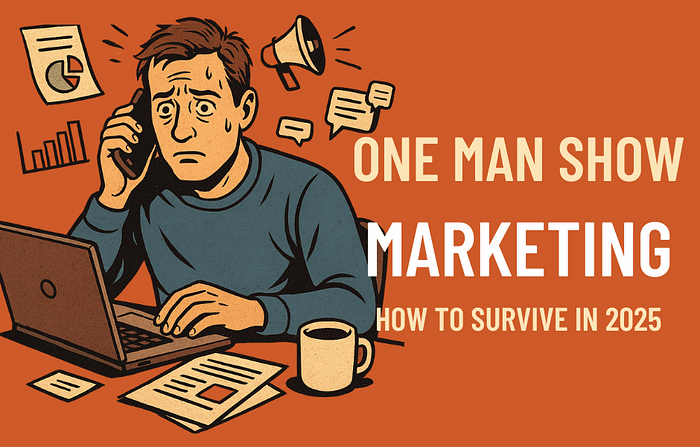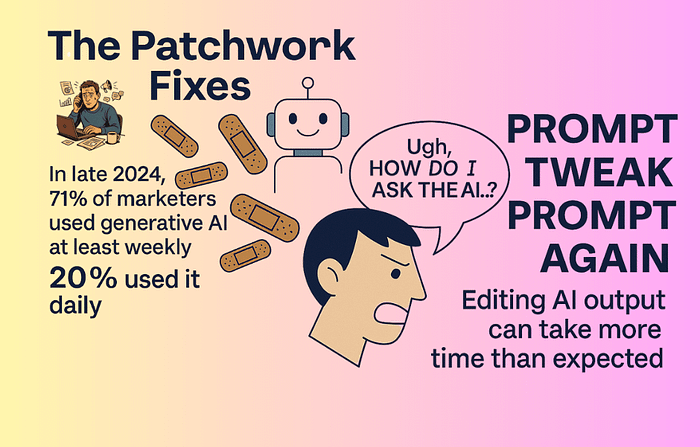- The Tools
The Tools of Your Trade
What is SimplerWork
Find out Find out
all about?
- Pricing
- About
- AI Insights
SimplerWork
- Send Us Mail
- Call 24/7 Hours
+99-763 684 4563
One Man Show Marketing: How to Survive in 2025
- Home
- Marketing Insights
- One Man Show Marketing: How to Survive in 2025

If you’re a startup founder, a solo marketer, or the one unlucky soul responsible for ‘doing all the marketing stuff’ — this is for you.
I’ve been living the one-man marketing show for a while when gearing up my new startup. When we started building SimplerWork, I didn’t just want to talk about solving marketing pain points for SMEs. I was the person feeling them. Still am, some days.
I’ve been that person juggling everything — drafting LinkedIn posts while replying to leads, writing a blog post with one hand and prepping sales follow-ups with the other. So this isn’t theory. It’s a lived reality. And if you’re in the same boat, I want to walk you through what’s working, what’s not, and how I’ve been figuring it out — step by chaotic step.

The Usual Grind
There’s no real job title for it, is there? Founder-slash-marketer-slash-sales. Whatever needs doing, you’re it. You’re the one who needs to build the brand, find the right words, write the content, post it, follow up with leads, keep momentum going, track results, and somehow still be “creative” while half your brain is worrying about Stripe integrations or support tickets.
The to-do list isn’t just long — it’s… layered. Draft content. Create visuals. Post. Measure. Update site. Test messaging. Follow up. Re-plan. And repeat.
There are wins, sure. But a lot of the time, it feels like you’re running and marketing and selling and building and hoping. Hoping it adds up to something.
That’s the grind. And if you feel it too, well — you’re definitely not alone.
Where the Time Actually Goes
Let me paint a picture that used to be my daily reality before SimplerWork got to the point it is now. I’d start the day wanting to post something meaningful on LinkedIn. I’d open a doc, stare at it, type a few words, delete them, draft a new idea with ChatGPT, tweak the tone, second-guess the message. Sometimes I’d scrap the whole thing.
I’d spend half the day tweaking the tone, rewriting entire chunks, trying to get it to sound less robotic and more like me. And formatting? Still on me. Still a time sink.
And then I’d hit end of the day, kids telling me I was absent, while I’d look back at what I actually got done, and realize strategy — funnel review, campaign planning, big-picture thinking — was nowhere on the board. Again.
The Patchwork Fixes
When you’re doing the work of an entire team, you naturally start looking for shortcuts (and chugging a lot of coffee). You might have ChatGPT open like an unpaid intern that never sleeps, ready to brainstorm a headline or polish a paragraph.

They’re decent patchwork solutions — like a bunch of helpful band-aids for your workload. But here’s the thing: even using AI can feel like work. You have to come up with the right prompts (“Ugh, how do I ask the AI to write this announcement and make it witty but not weird?”). Then you often need to edit the output, because let’s face it, the first draft from AI can be a little off — maybe too generic, or the tone isn’t quite human enough (yea what’s up with that issue?), often lacking the nuance or context you know your audience needs. So you find yourself iterating: prompt, tweak, prompt again, tweak again. By the time you wrangle a solid paragraph, you’ve sunk more time than you expected.
So, What’s Actually Working
Now let’s talk solutions. The obvious wish is “I need to clone myself,” but until science figures that out, the next best thing is working smarter with the right tools and processes.
Imagine an assistant that could handle the grunt work of creating content, following best-practice frameworks, and leaving you with just the fine-tuning. Less blank-page panic, more quick editing of a decent draft. Sounds amazing, right?
This is where we need to shift from DIY everything to guided execution. It’s about finding tools that don’t just spit out text and say “good luck,” but actually walk you through it. Think of it like this: instead of you asking the AI 10 times how to write a LinkedIn post for your product launch, what if the tool asked you the right questions and then gave you the post, already structured and polished?
Part of this is mindset too: letting go of the feeling that you must personally handcraft every sentence from scratch. It’s okay to use a template or a good AI draft as a starting point — your expertise is in shaping the message and knowing your customer, not typing every word the hard way.
Enter SimplerWork. In short, it’s a new tool built exactly for people like you — the one-person (or very small) marketing team that needs to get real marketing work done fast, without becoming an AI prompt engineer.
“Let’s make an AI-powered tool that actually feels like a marketing assistant and not a science project.”
How? By baking in a ton of guidance and best practices, so you’re not starting from zero every time. You log in, and it’s like a menu of common marketing tasks: need to whip up a marketing email or newsletter? There’s a module for that. Social media posts? Blog content? It’s got those too.
You pick the task, answer a few straightforward questions, and then bam! it produces a first draft that doesn’t read like a robot wrote it. The content comes out structured and pretty darn human-sounding, as if a seasoned marketer drafted it, not an AI stuck in “blah generic mode.” The best part: no blank page, no prompting.
We’re not trying to reinvent marketing. We’re just trying to remove the friction from doing it. And when you’re wearing 5 hats, that friction matters.
Surviving (and Thriving) in 2025
Let’s wrap this up on a high note. Yes, marketing in 2025 as a lone wolf is tough. The grind is real, the hours long, and the coffee strong. But you know what? You’ve got better tools now that finally understand what your needs are. The key to surviving (even thriving) is embracing those helpers: lean into tools like SimplerWork that are built for the way you actually work.
Give yourself permission to offload the mechanical stuff and focus on what only you can do: the creative ideas, the relationships, the planning.
Marketing in 2025 isn’t about doing more with nothing — it’s about doing more with smarter support. When you have a sidekick that “gets” your one-person show, suddenly the future looks a lot more manageable. You might even reclaim some free time. So, keep your chin up. With the right approach and the right tech in your corner, you’ve got this. Here’s to working smarter, staying sane, and watching your marketing actually take off in 2025.
P.S. In case it wasn’t obvious — I’ve been trying to convince you to give SimplerWork a shot. It’s free to try, no friction to it, and comes with a 14-day trial. Might just change how you do marketing.





